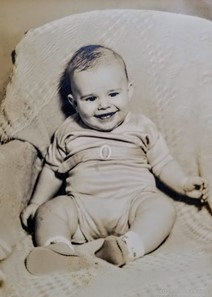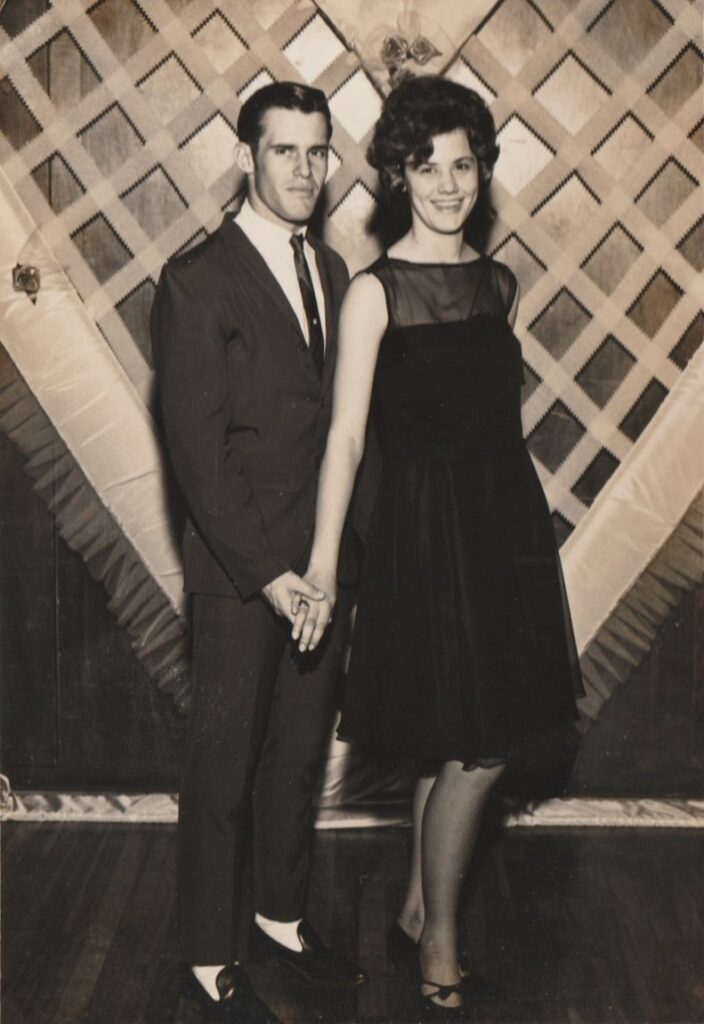To preserve the rich history of Flour Bluff, The Paper Trail News, runs historical pieces and personal accounts about the life and times of the people who have inhabited the Encinal Peninsula. The stories gleaned from interviews held with people who remember what it was like to live and work in Flour Bluff in the old days are intended to connect the past with the present.
[spacer height=”20px”]
[spacer height=”20px”]
Until Miles Graham’s family took a quick trip to California to pick up a nephew who wasn’t much younger than he, this Flour Bluff boy had not left the Encinal Peninsula.
“Dad loaded Mom, my sister Carol, and I into our old Chevy and headed for California,” said Miles. “Our family never had a new car, and I had never been across the Oso until then.”
Miles spent a lot of time playing with the kids who lived near his house on Flour Bluff Drive. “The Smiths, Croftons, O’Briens, and Kelleys lived along Flour Bluff Drive and Graham Road,” said Miles. “We walked all over Flour Bluff, and we used to hunt hogs and dove all up and down the Oso. I remember shooting a duck once, and my mom cooked it up for me. That’s when I learned I didn’t like duck. Nobody had air conditioning except the Smiths, so we were always outside.”
Miles said that he went to Flour Bluff School from first through twelfth grades, graduating in 1967. “The only part of the school that was air conditioned was the office and the library,” he said. “My first-grade classroom is still standing. It’s in the cream-colored buildings behind the ECC. That was first through third when I was in school. The red building where the university prep school is now was the junior high, and it had 6th through 8th grades. It didn’t have air conditioning either. The first structure to be built east of Waldron was Wranosky gym and then central office.”
[spacer height=”20px”]
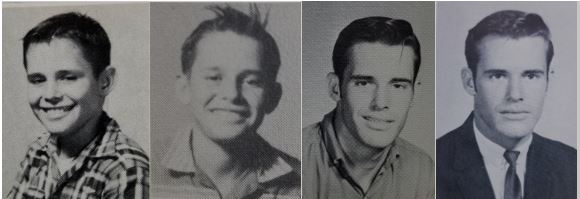
Miles Graham (L to R): 4th grade, 5th grade, junior year, senior year (Source: Flour Bluff Hornet Yearbooks)
“The multipurpose building, which is Central Kitchen now, was where everyone at lunch when I was in high school,” said Miles. “Well, some of us left campus and went to Dairy Queen or somewhere else. We were technically a closed campus, but the understood rule was don’t go do something stupid and be back when you’re supposed to be back. That worked most of the time.”
Times were changing, even for the Flour Bluff teenagers. “In the years before I got into high school, most of the teenagers hung out at Odonavich’s Dairy Queen near the causeway,” said Miles, “but my class would get enough money together to buy gas and cross the Oso to go into town and cruise around or go to Pick’s Drive-In. Sometimes we drove to Port Aransas because lots of our friends lived over there but went to school in Flour Bluff because they didn’t have a high school. They could go to Aransas Pass or Flour Bluff, and most chose the Bluff. We sent busses to pick them up.”
[spacer height=”20px”]
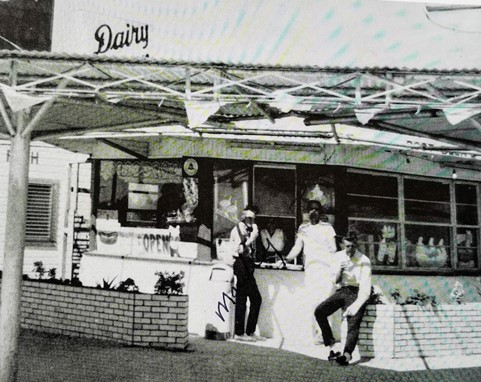
Maubry Nelson, Mrs. Odonavitch (in window), Mr. Odonavich, and Barry Dalton at Dairy Queen in Flour Bluff, ca. 1962 (FB Hornet Yearbook photo)
[spacer height=”20px”]
“When we drove to Port Aransas – especially at night – we drove down the beach more often than we drove the road. The fish pass wasn’t there then,” Miles said. “Cattle still roamed the island, and they kept the vegetation down. There were times when we’d get really strong southeast winds that would push the sand onto the road to Port A. There were cases of people driving that road at night who had wrecks because they ran into what they called a ‘walking sand dune.’ Sometimes there would be 6 to 8 inches of sand on that road. When people started pulling their cattle off the island, the vegetation came back, and that didn’t happen anymore.”
Miles spoke of the “haunted house” that served as a way to have a little fun in the sixties. “After football games, we’d get a bunch of kids together – some from here and some from in town – and take them to the old Ritter house that sat up in the brush at the east end of Don Patricio,” said Miles. “Our goal, of course, was to take them through the brush in the dark and really scare them. The house was full of pigeons, but we convinced everybody they were bats. I remember getting caught down there one night not long after the city took over. Sandy and I were going together, and she was with about 20 of us. We could see the lights of a couple of police cars, so we decided to go to them instead of letting them come get us. The path was pretty well beaten, so they could easily get to us. They shined their lights down the path, and out we came single file. Sandy kept standing behind me. The police asked for our licenses, wrote our names down, and let us know we were violating curfew. One policeman, an officer named Sullivan, saw Sandy’s name and called her out asking her what she was doing out there with all of us. She was so embarrassed. Then, they told us we had ten minutes to get home and warned us that they’d take us to jail if they caught us out on the street and call our parents. Everybody scattered.”
“Sometimes we could get our hands on a few beers,” Miles said. “There used to be an old bar on Laguna Shores where the Exxon dock is. Some guy, maybe some old squatter, had a shack at the end of that well road. That guy had a bar in it with about six bar stools. If you could see over the bar, he’d sell you a beer.”
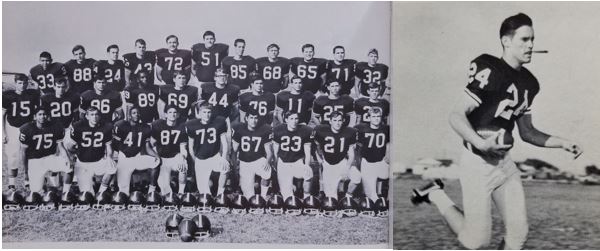
(L to R) Hornet Varsity Football Team, 1967; Miles Graham’s made the varsity team his sophomore year (Photo credits: Flour Bluff Hornet Yearbook 1965 and 1967)
[spacer height=”20px”]
Miles thrived in high school. He ran track and played football and basketball from junior high through his sophomore year. Then, he focused on football his junior and senior years. He also worked for HEB from tenth to twelfth grades. More importantly, he focused on learning a marketable skill. “During those last two years in high school, I was enrolled in vocational drafting class which led to employment immediately upon leaving school,” Miles recalled. “I can thank a teacher, Marion Collins, for teaching me the basic skills to build on and earn a living for many years. I attended Del Mar for two years but did not earn a degree.”
[spacer height=”20px”]
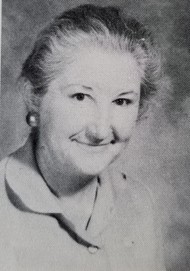
Dorothy Collins, Flour Bluff High School drafting teacher (Source: Flour Bluff Hornet Yearbook 1973)
Flour Bluff Schools and Mrs. Collins in particular prepared Miles for the workforce. “I went to work as a draftsman for Urban Engineering straight out of high school in 1967 and worked there until 1976. Then, I worked as an engineering technician in design and preparation of construction plans for municipal projects, land developments, and surveying projects throughout the state. After that, I went to work for Shearer Engineering from 1976 to 1981 until I started my own residential contracting business building and remodeling homes in Corpus Christi.”
Miles turned to banking in 1986, working as a commercial loan officer for 1st National Bank of Flour Bluff. “Then I worked for several local and statewide banks, including First City Texas, 1st Commerce Bank Corpus Christi, Kleberg Bank, and 1st Community Bank Padre Island,” he said. “My primary area of lending was residential land development and home building in the South Texas area. I retired as Executive Vice President 1st Community Bank in 2017.”
In the midst of all this work, Miles started his family. He married his high school sweetheart, Sandy Pella. They raised one son, Paul Anthony Graham, who married Catherine Dempsey Graham, and continued the Graham bloodline through their children: Austin Ray Graham, McKenzie Gayle Graham, and Zachary Ryan Graham.
[spacer height=”20px”]
In the tradition of the Grahams who came before him, Miles gave back to the school and community that gave him so much. He coached and refereed youth sports in Flour Bluff, including Laguna Little League and Flour Bluff Youth Soccer and even found time to serve on the Flour Bluff and Coastal Bend Youth Soccer boards. He was once president of the Bucaraders, the group that organizes the Buc Days Parade and events. Miles also served on the board of the Corpus Christi Area Builders Association and the Goodwill of South Texas as a member of the Flour Bluff Business Association and Padre Island Architectural Control Committee. He held a two-year term on the Governor’s Advisory Council for Texas Homeowners and served on the Re-Open Packery Channel Association. Add to that his time as a Flour Bluff School Board member and founding member of the Flour Bluff Foundation for Educational Excellence, and it is not hard to understand why he was chosen as one of the first inductees to the Flour Bluff Athletic Hall of Fame, an award for those who excelled in school, athletics, and in life.
When asked if he ever left Flour Bluff, Miles said, “I would not have wanted to be anywhere else,” said Miles. “I lived in Corpus Christi for about three years. My wife Sandy and I could not wait to get back to FB where we both grew up.”
Sources: In 1998-1999, Cassandra Self-Houston, great granddaughter of Florine Jeletich Self and John Self, conducted interviews of members of the first Flour Bluff families still living in Flour Bluff at that time. The Graham story was gleaned from these interviews and multiple Corpus Christi Caller-Times, The Alice News, and Flour Bluff Sun articles written about Dr. Robert Graham and his family. More specific dates and information came from cards and letters of family members and from interviews with Miles Graham and Sherry Holloway conducted in 2019.
_______________________________________________________
Be sure to visit The Paper Trail News to read stories from other longtime residents of Flour Bluff. The editor welcomes all corrections or additions to the stories to assist in creating a clearer picture of the past. Please contact the editor at [email protected] to submit a story about the early days of Flour Bluff.
